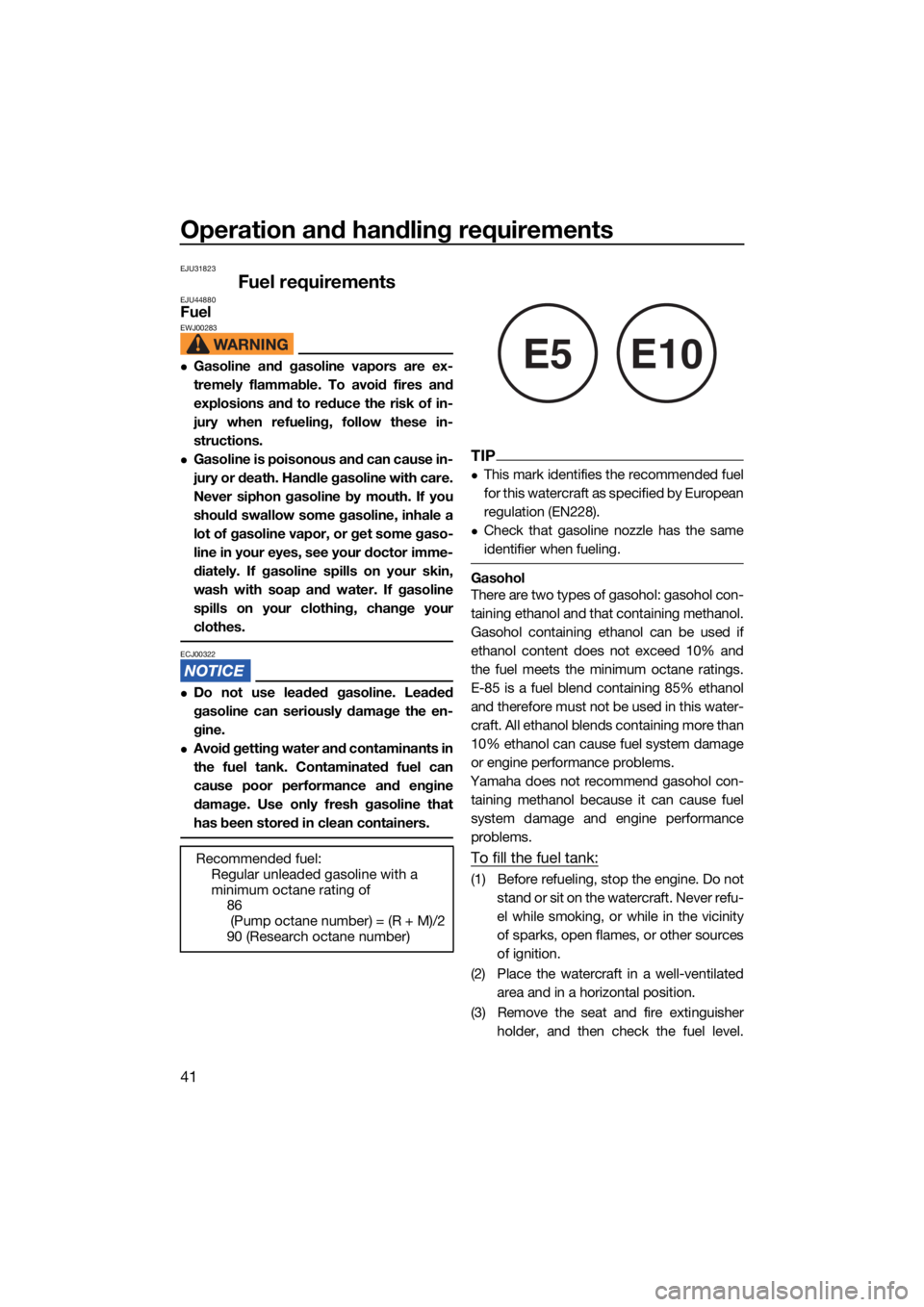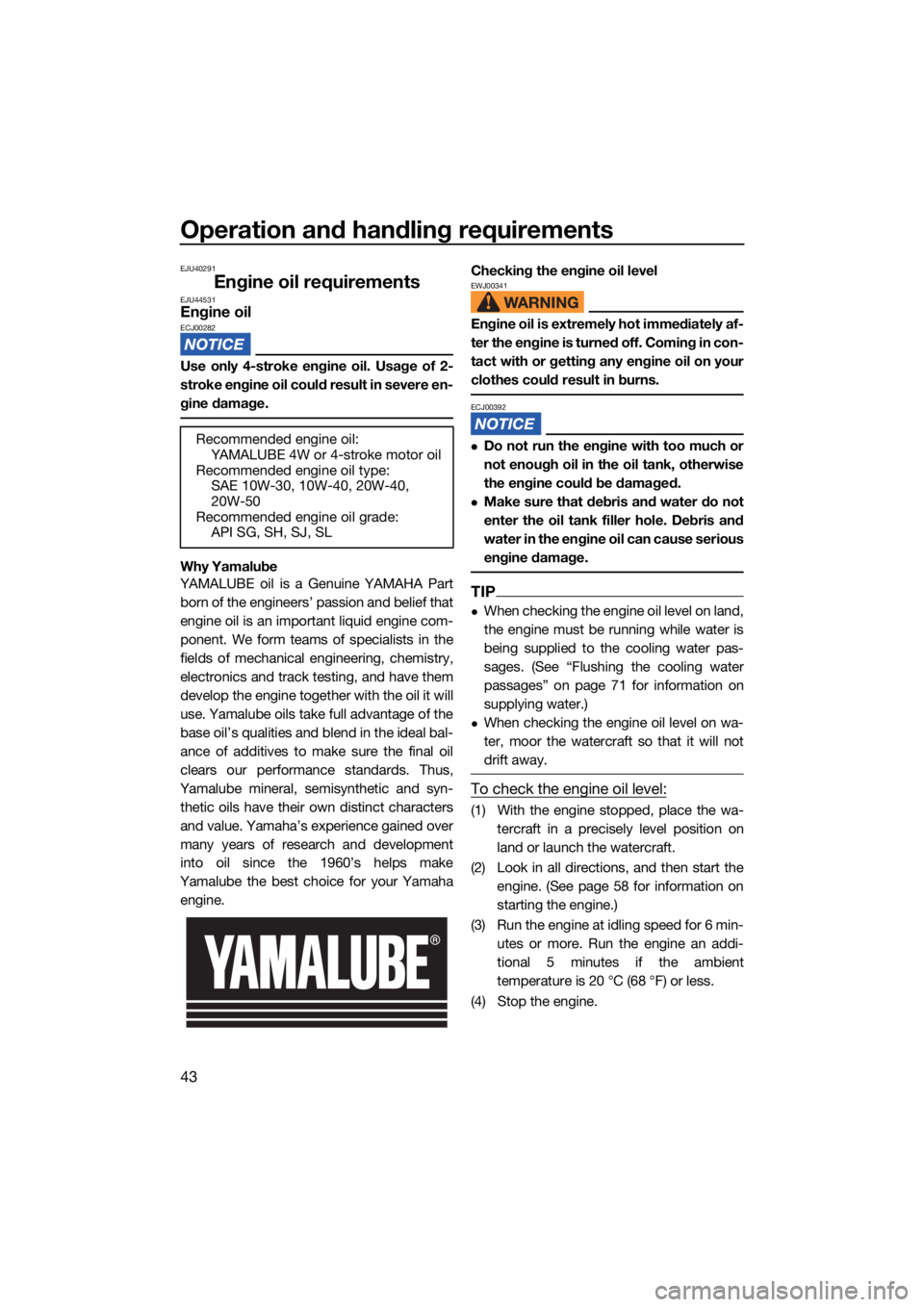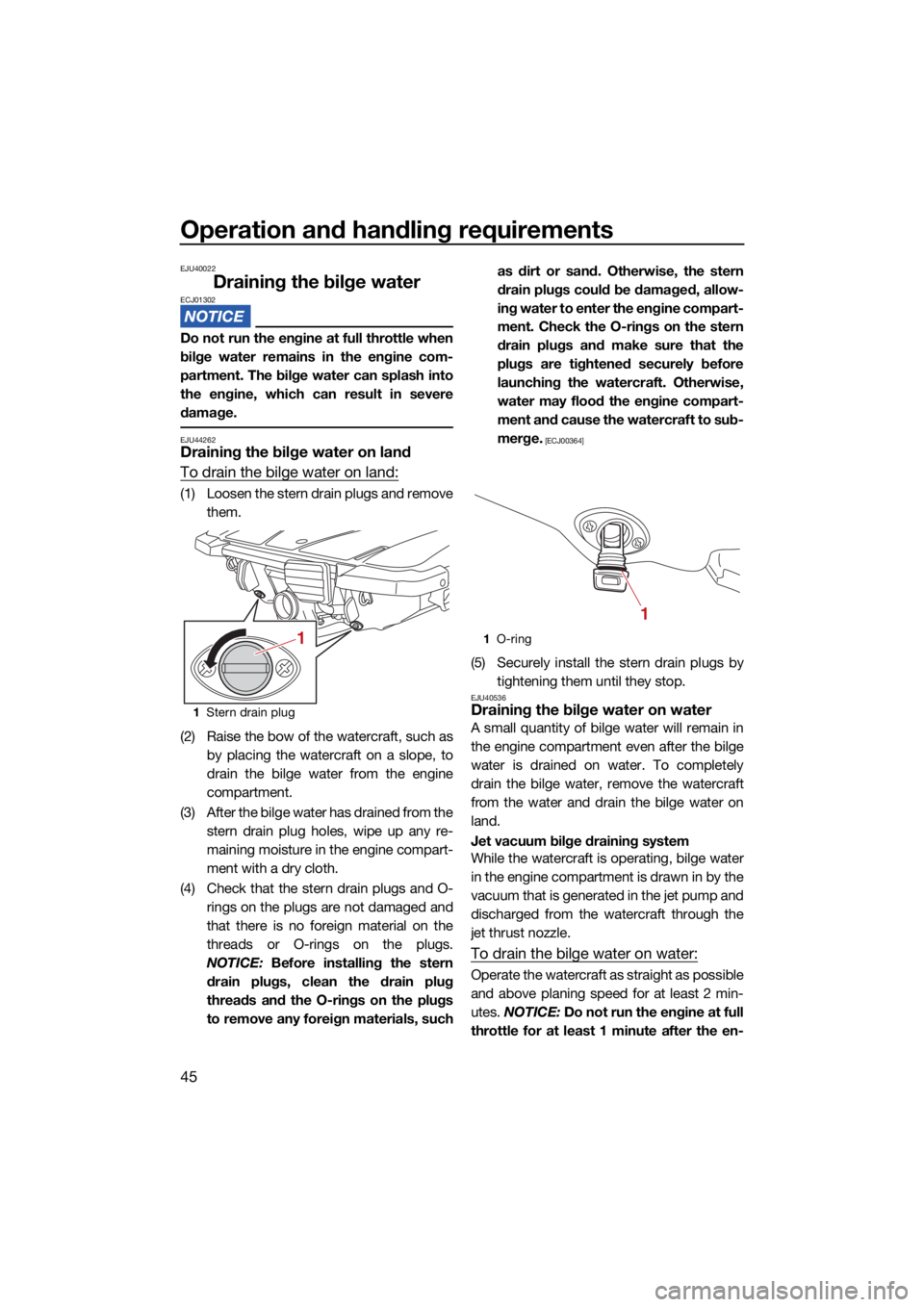check engine YAMAHA EX 2022 User Guide
[x] Cancel search | Manufacturer: YAMAHA, Model Year: 2022, Model line: EX, Model: YAMAHA EX 2022Pages: 100, PDF Size: 4.74 MB
Page 48 of 100

Operation and handling requirements
41
EJU31823
Fuel requirementsEJU44880FuelEWJ00283
Gasoline and gasoline vapors are ex-
tremely flammable. To avoid fires and
explosions and to reduce the risk of in-
jury when refueling, follow these in-
structions.
Gasoline is poisonous and can cause in-
jury or death. Handle gasoline with care.
Never siphon gasoline by mouth. If you
should swallow some gasoline, inhale a
lot of gasoline vapor, or get some gaso-
line in your eyes, see your doctor imme-
diately. If gasoline spills on your skin,
wash with soap and water. If gasoline
spills on your clothing, change your
clothes.
ECJ00322
Do not use leaded gasoline. Leaded
gasoline can seriously damage the en-
gine.
Avoid getting water and contaminants in
the fuel tank. Contaminated fuel can
cause poor performance and engine
damage. Use only fresh gasoline that
has been stored in clean containers.
TIP
This mark identifies the recommended fuel
for this watercraft as specified by European
regulation (EN228).
Check that gasoline nozzle has the same
identifier when fueling.
Gasohol
There are two types of gasohol: gasohol con-
taining ethanol and that containing methanol.
Gasohol containing ethanol can be used if
ethanol content does not exceed 10% and
the fuel meets the minimum octane ratings.
E-85 is a fuel blend containing 85% ethanol
and therefore must not be used in this water-
craft. All ethanol blends containing more than
10% ethanol can cause fuel system damage
or engine performance problems.
Yamaha does not recommend gasohol con- taining methanol because it can cause fuel
system damage and engine performance
problems.
To fill the fuel tank:
(1) Before refueling, stop the engine. Do not stand or sit on the watercraft. Never refu-
el while smoking, or while in the vicinity
of sparks, open flames, or other sources
of ignition.
(2) Place the watercraft in a well-ventilated area and in a horizontal position.
(3) Remove the seat and fire extinguisher holder, and then check the fuel level.
Recommended fuel:
Regular unleaded gasoline with a
minimum octane rating of86
(Pump octane number) = (R + M)/2
90 (Research octane number)
E5E10
UF3Y75E0.book Page 41 Tuesday, July 27, 2021 2:27 PM
Page 50 of 100

Operation and handling requirements
43
EJU40291
Engine oil requirementsEJU44531Engine oilECJ00282
Use only 4-stroke engine oil. Usage of 2-
stroke engine oil could result in severe en-
gine damage.
Why Yamalube
YAMALUBE oil is a Genuine YAMAHA Part
born of the engineers’ passion and belief that
engine oil is an important liquid engine com-
ponent. We form teams of specialists in the
fields of mechanical engineering, chemistry,
electronics and track testing, and have them
develop the engine together with the oil it will
use. Yamalube oils take full advantage of the
base oil’s qualities and blend in the ideal bal-
ance of additives to make sure the final oil
clears our performance standards. Thus,
Yamalube mineral, semisynthetic and syn- thetic oils have their own distinct characters
and value. Yamaha’s experience gained over
many years of research and development
into oil since the 1960’s helps make
Yamalube the best choice for your Yamaha engine. Checking the engine oil level
EWJ00341
Engine oil is extremely hot immediately af-
ter the engine is turned off. Coming in con-
tact with or getting any engine oil on your
clothes could result in burns.
ECJ00392
Do not run the engine with too much or
not enough oil in the oil tank, otherwise
the engine could be damaged.
Make sure that debris and water do not
enter the oil tank filler hole. Debris and
water in the engine oil can cause serious
engine damage.
TIP
When checking the engine oil level on land,
the engine must be running while water is
being supplied to the cooling water pas-
sages. (See “Flushing the cooling water
passages” on page 71 for information on
supplying water.)
When checking the engine oil level on wa-
ter, moor the watercraft so that it will not
drift away.
To check the engine oil level:
(1) With the engine stopped, place the wa-
tercraft in a precisely level position on
land or launch the watercraft.
(2) Look in all directions, and then start the engine. (See page 58 for information on
starting the engine.)
(3) Run the engine at idling speed for 6 min- utes or more. Run the engine an addi-
tional 5 minutes if the ambient
temperature is 20 °C (68 °F) or less.
(4) Stop the engine.
Recommended engine oil:
YAMALUBE 4W or 4-stroke motor oil
Recommended engine oil type: SAE 10W-30, 10W-40, 20W-40,
20W-50
Recommended engine oil grade: API SG, SH, SJ, SL
UF3Y75E0.book Page 43 Tuesday, July 27, 2021 2:27 PM
Page 52 of 100

Operation and handling requirements
45
EJU40022
Draining the bilge waterECJ01302
Do not run the engine at full throttle when
bilge water remains in the engine com-
partment. The bilge water can splash into
the engine, which can result in severe
damage.
EJU44262Draining the bilge water on land
To drain the bilge water on land:
(1) Loosen the stern drain plugs and removethem.
(2) Raise the bow of the watercraft, such as by placing the watercraft on a slope, to
drain the bilge water from the engine
compartment.
(3) After the bilge water has drained from the stern drain plug holes, wipe up any re-
maining moisture in the engine compart-
ment with a dry cloth.
(4) Check that the stern drain plugs and O- rings on the plugs are not damaged and
that there is no foreign material on the
threads or O-rings on the plugs.
NOTICE: Before installing the stern
drain plugs, clean the drain plug
threads and the O-rings on the plugs
to remove any foreign materials, such as dirt or sand. Otherwise, the stern
drain plugs could be damaged, allow-
ing water to enter the engine compart-
ment. Check the O-rings on the stern
drain plugs and make sure that the
plugs are tightened securely before
launching the watercraft. Otherwise,
water may flood the engine compart-
ment and cause the watercraft to sub-
merge.
[ECJ00364]
(5) Securely install the stern drain plugs by
tightening them until they stop.
EJU40536Draining the bilge water on water
A small quantity of bilge water will remain in
the engine compartment even after the bilge
water is drained on water. To completely
drain the bilge water, remove the watercraft
from the water and drain the bilge water on
land.
Jet vacuum bilge draining system
While the watercraft is operating, bilge water
in the engine compartment is drawn in by the
vacuum that is generated in the jet pump and
discharged from the watercraft through the
jet thrust nozzle.
To drain the bilge water on water:
Operate the watercraft as straight as possible
and above planing speed for at least 2 min-
utes. NOTICE: Do not run the engine at full
throttle for at least 1 minute after the en-
1 Stern drain plug
11O-ring
1
UF3Y75E0.book Page 45 Tuesday, July 27, 2021 2:27 PM
Page 54 of 100

First-time operation
47
EJU32787
Engine break-inECJ00432
Failure to perform the engine break-in
could result in reduced engine life or even
severe engine damage.
The engine break-in is essential to allow the
various components of the engine to wear
and polish themselves to the correct operat-
ing clearances. This ensures proper perfor-
mance and promotes longer component life.
To perform the engine break-in:
(1) Check the engine oil level. (See page 43for information on checking the engine
oil level.)
(2) Launch the watercraft and start the en- gine. (See page 58 for information on
starting the engine.)
(3) For the first 5 minutes, operate with the engine at idling speed.
(4) For the next 30 minutes, operate with the engine speed below 5000 r/min.
(5) For the next 1 hour, operate with the en- gine speed below 6500 r/min.
After the engine break-in is complete, the wa-
tercraft can be operated normally.
UF3Y75E0.book Page 47 Tuesday, July 27, 2021 2:27 PM
Page 55 of 100

Pre-operation checks
48
EJU31984
EWJ00413
Failure to inspect or maintain the watercraft properly increases the possibility of an ac-
cident or damage to the watercraft. Do not operate the watercraft if you find any prob-
lem. If a problem cannot be corrected by the procedures provided in this manual, have
the watercraft inspected by a Yamaha dealer.
EJU41237Pre-operation checklist
Before using this watercraft, be sure to perform the checks in the following checklist.
PRE-LAUNCH CHECKS
ITEM ROUTINEPAGE
Engine compartment Ventilate the engine compartment.
Check inside the engine compartment for damage.
50
Fuel system Check the fuel system for leakage.
Check the fuel level in the fuel tank.
50
Water separator Check the water separator for water. 50
Engine unit Check the exterior of the engine unit for damage. 51
Engine oil level Check the engine oil level. 51
Bilge water Check the engine compartment for bilge water. 51
Battery Check the battery connections. 51
Steering system Check the steering system for proper operation. 52
Reverse system (EX
SPORT) Check the reverse system for proper operation.
52
RiDE lever (EX DELUXE /
EX LIMITED) Check the RiDE lever for proper operation.
53
Throttle lever Check the throttle lever for proper operation. 53
Engine shut-off cord (lan-
yard) Check the engine shut-off cord (lanyard) for dam-
age.
53
Switches Check the start switch, engine stop switch, and en-
gine shut-off switch for proper operation.
53
Storage compartments Check the storage compartments for damage and
water.
54
Fire extinguisher holder Check the fire extinguisher holder for damage. 54
Fire extinguisher Check the condition of the fire extinguisher. 54
Safety equipment Check that safety equipment meeting the applica-
ble regulations is on board.
54
Hull and deck Check the hull and deck for damage. 54
Jet intake Check the jet intake for damage and clogging. 54
Jet thrust nozzle and re-
verse gate (EX SPORT / EX
DELUXE / EX LIMITED) Check the jet thrust nozzle and reverse gate for
damage.
54
UF3Y75E0.book Page 48 Tuesday, July 27, 2021 2:27 PM
Page 56 of 100

Pre-operation checks
49
POST-LAUNCH CHECKS
TIP
To ensure safety and reliability, pre-operation checks should be made each time the water-
craft is used.
Stern drain plugs Check the stern drain plugs for damage and foreign
material and check that they are securely installed.
55
Hood Check that the hood is securely closed. 55
Seat Check that the seat is securely installed. 36
ITEM ROUTINE PAGE
Cooling water pilot outlet Check that water is discharged from the cooling
water pilot outlet while the engine is running.
55
Multifunction information
center Check the multifunction information center for prop-
er operation.
56
Shift system (EX DELUXE /
EX LIMITED) Check the shift system for proper operation. 56
Engine idling speed Check the engine idling speed. 56
ITEM ROUTINE PAGE
UF3Y75E0.book Page 49 Tuesday, July 27, 2021 2:27 PM
Page 57 of 100

Pre-operation checks
50
EJU32282
Pre-operation check pointsEJU44551Pre-launch checks
Perform the pre-launch checks in the pre-op-
eration checklist while the watercraft is on
land.
To perform the pre-launch checks:
(1) Remove the seat, seat storage compart-ment, and fire extinguisher holder. (See
page 36 for seat removal and installation
procedures, page 40 for information on
the seat storage compartment, and page
40 for information on the fire extinguisher
holder.)
(2) Perform the checks and make sure that there are no malfunctioning items or oth-
er problems.
(3) After completing these checks, securely install the seat storage compartment, fire
extinguisher holder, and seat in their
original positions.
EJU32334Engine compartment checkEWJ00462
Failure to ventilate the engine compart-
ment could result in a fire or explosion. Do
not start the engine if there is a fuel leak.
Ventilate the engine compartment. Leave the
engine compartment open for a few minutes
to allow any fuel vapors to escape.
Make sure that there is no damage inside the
engine compartment.
EJU34215Fuel system checksEWJ00382
Leaking fuel can result in fire or explosion.
Check for fuel leakage regularly.
If any fuel leakage is found, the fuel sys-
tem must be repaired by a qualified me-
chanic. Improper repairs can make the
watercraft unsafe to operate.
Make sure that there is no damage, leakage,
or other problem in the fuel system.
Check:
Fuel filler cap and seal for damage
Fuel tank for damage and leakage
Fuel hoses and joints for damage and leak-
age
Fuel tank breather hose for damage and
leakage
EJU36875Fuel level check
Check the fuel level in the fuel tank.
Add fuel if necessary. (See page 41 for infor-
mation on filling the fuel tank.)
EJU32424Water separator check
Make sure that no water has collected in the
water separator. If water has collected in the
water separator, drain it. (See page 26 for in-
formation on draining the water separator.)
UF3Y75E0.book Page 50 Tuesday, July 27, 2021 2:27 PM
Page 58 of 100

Pre-operation checks
51
EJU40182Engine unit check
Check the exterior of the engine unit for dam-
age or other problem.
EJU41561Engine oil level check
Make sure that the engine oil level is between
the minimum and maximum level marks on
the dipstick attached to the oil tank filler cap.
(See page 43 for information on checking the
engine oil level.)
EJU32456Bilge water check
Make sure that no bilge water has collected in
the engine compartment. If bilge water has
collected in the engine compartment, drain it.
(See page 45 for information on draining the
bilge water.)
EJU32488Battery checks
Make sure that the battery terminals are not
damaged and that the battery leads are con-
nected properly. WARNING! Never operate
the watercraft if the battery does not have
sufficient power to start the engine or if it
shows any other signs of decreased pow-
er. Loss of battery power may leave you
stranded.
[EWJ01242]
1 Water separator
1 Oil tank filler cap/Dipstick
1
1
1Dipstick
2 Maximum level mark
3 Minimum level mark
1 Negative (–) battery terminal: Black lead
2 Positive (+) battery terminal: Red lead
213
1
2
UF3Y75E0.book Page 51 Tuesday, July 27, 2021 2:27 PM
Page 60 of 100

Pre-operation checks
53
EJU43213RiDE lever checks (EX DELUXE / EX
LIMITED) Operate the RiDE lever several times to make
sure that operation is smooth throughout the
whole range. Also, make sure that the RiDE
lever returns automatically to its fully closed
position when released.
EJU42181Throttle lever checks
Operate the throttle lever several times to
make sure that operation is smooth through- out the whole range. Also, make sure that the
throttle lever returns automatically to its fully
closed (idle) position when released.
EJU32666Engine shut-off cord (lanyard) check
Make sure that the engine shut-off cord (lan-
yard) is not damaged. If the cord is damaged,
replace it.
WARNING! Never try to repair
the engine shut-off cord (lanyard) or tie it
together. The engine shut-off cord (lan-
yard) may not pull free when the operator
falls off, allowing the watercraft to contin-
ue to run and cause an accident.
[EWJ01222]
EJU40692
Switch checksECJ01311
Do not run the engine over 4000 r/min on
land. Also, do not run the engine for more
than 15 seconds without supplying water,
otherwise the engine could overheat.
1 Stopper
1
UF3Y75E0.book Page 53 Tuesday, July 27, 2021 2:27 PM
Page 61 of 100

Pre-operation checks
54
Check the start switch, the engine stop
switch, and the engine shut-off switch for
proper operation. (See pages 24 to 24 for in-
formation on operating each switch.)
To check the operation of the switches:
(1) Push the start switch to make sure thatthe engine starts.
(2) As soon as the engine starts running, push the engine stop switch to make
sure that the engine stops immediately.
(3) Restart the engine, and then pull the en- gine shut-off cord (lanyard) to remove
the clip from the engine shut-off switch
to make sure that the engine stops im-
mediately.
EJU40102Storage compartment checks
Make sure that the storage compartments
are not damaged and that water has not col-
lected in the compartments. (See page 38 for
information on the storage compartments.)
EJU44670Fire extinguisher holder checks
Make sure that the fire extinguisher holder is
installed in the correct direction and is not
damaged. (See page 40 for information on
the fire extinguisher holder.)
EJU44630Fire extinguisher check
Check that there is a full fire extinguisher on
board.
To check the fire extinguisher, see the in-
structions supplied by the fire extinguisher
manufacturer. Always keep the fire extin-
guisher stored in the holder.
Always carry a fire extinguisher on board. A
fire extinguisher is not standard equipment
with this watercraft. If you do not have one,
contact a Yamaha dealer or a fire extinguish-
er dealer to obtain one meeting the proper
specifications.
EJU40122Safety equipment check
Check that safety equipment meeting the ap-
plicable regulations is on board.
EJU32353Hull and deck check
Check the hull and deck for damage or other
problem.
EJU32657Jet intake checks
Make sure that the jet intake is not damaged
or clogged with weeds or debris. If the jet in-
take is clogged, clean it. (See page 86 for in-
formation on the jet intake.)
EJU43221Jet thrust nozzle and reverse gate check
(EX SPORT / EX DELUXE / EX LIMITED)
Check the jet thrust nozzle and reverse gate
for damage or other problem.
1Start switch
2 Engine stop switch
3 Engine shut-off switch
4 Clip
5 Engine shut-off cord (lanyard)
1
3
4
25
UF3Y75E0.book Page 54 Tuesday, July 27, 2021 2:27 PM